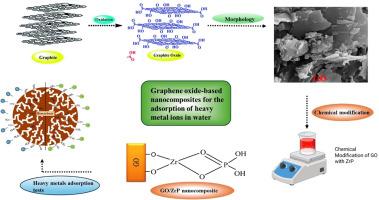氧化石墨烯及其与过渡金属磷酸盐复合材料在水净化领域的合成、形态和结构研究进展
IF 3.9
Q2 MATERIALS SCIENCE, MULTIDISCIPLINARY
引用次数: 0
摘要
氧化石墨烯(GO)基纳米复合材料在当今生活中有着广泛的应用,其中水净化是最主要的应用。最近研究的氧化石墨烯基纳米复合材料包括过渡金属磷酸盐(TMPs)(磷酸锆(ZrP)、磷酸钴(CoP)、磷酸银(AgP)、磷酸镍(NiP)和磷酸钛(TiP))。与其他氧化石墨烯基纳米复合材料相比,用过渡金属磷酸盐修饰氧化石墨烯增加了其含氧官能团的数量。TMPs提高了氧化石墨烯对重金属的吸附效率。此外,它们通常改善其热稳定性和离子交换性能,使其成为广泛应用的理想选择。对于水处理应用,在研究纳米复合材料的净水效果之前,了解其结构和形态特性是至关重要的。因此,有必要列出合适的方法和相关的测试来研究所制备的纳米复合材料的有效性。在有毒重金属吸附试验中,pH、吸附剂与吸附物之间的相互作用以及接触时间是影响吸附效果的重要参数。毒性最大的重金属包括汞(Hg)、铅(Pb)、镉(Cd)和砷(As)。本研究旨在综述氧化石墨烯、过渡金属磷酸盐和氧化石墨烯基纳米复合材料的形态和结构特性,以及它们作为水中有毒重金属吸附剂的潜在用途。本文章由计算机程序翻译,如有差异,请以英文原文为准。

Synthesis, morphology, and structural properties of graphene oxide (GO) and its composites with transition metal phosphates for application in water purification: A review
Graphene oxide (GO)-based nanocomposites have numerous applications in today's life, with water purification being the leading one. The recently studied GO-based nanocomposites include transition metal phosphates (TMPs) (zirconium phosphate (ZrP), cobalt phosphate (CoP), silver phosphate (AgP), nickel phosphate (NiP), and titanium phosphate (TiP). The modification of GO with transition metal phosphates increases its number of oxygen-containing functional groups, as compared to other GO-based nanocomposites. The TMPs improve the heavy metals adsorption efficiency of GO. Moreover, they generally improve its thermal stability and ion exchange properties, making it ideal for a large spectrum of applications. For water treatment applications, it is crucial to understand the structural and morphological properties of the prepared nanocomposites before studying their effectiveness in purifying water. Thereafter, it is necessary to table out the appropriate method and the relevant tests required to study the effectiveness of the prepared nanocomposite. The effect of pH, interactions between adsorbent and adsorbate, and contact time are some of the important parameters during the adsorption tests of toxic heavy metals. The most toxic heavy metals include mercury (Hg), lead (Pb), cadmium (Cd), and arsenic (As). This study is intended to review the GO, transition metal phosphates, and GO-based nanocomposite's morphology and structural properties, as well as their potential use as toxic heavy metal adsorbents in water.
求助全文
通过发布文献求助,成功后即可免费获取论文全文。
去求助
来源期刊

Carbon Trends
Materials Science-Materials Science (miscellaneous)
CiteScore
4.60
自引率
0.00%
发文量
88
审稿时长
77 days
 求助内容:
求助内容: 应助结果提醒方式:
应助结果提醒方式:


